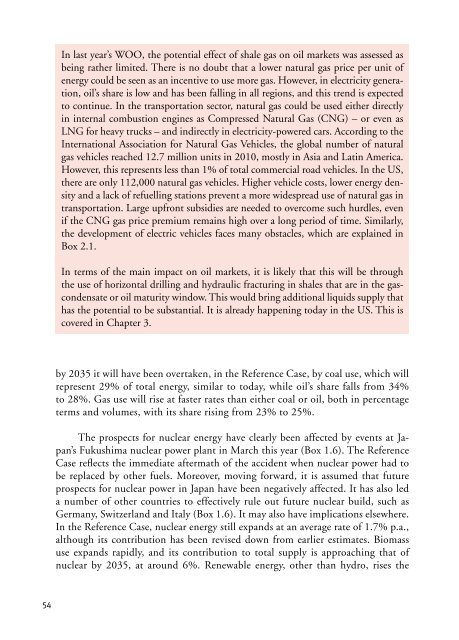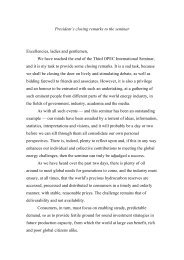Section One
Section One
Section One
Create successful ePaper yourself
Turn your PDF publications into a flip-book with our unique Google optimized e-Paper software.
54<br />
In last year’s WOO, the potential effect of shale gas on oil markets was assessed as<br />
being rather limited. There is no doubt that a lower natural gas price per unit of<br />
energy could be seen as an incentive to use more gas. However, in electricity generation,<br />
oil’s share is low and has been falling in all regions, and this trend is expected<br />
to continue. In the transportation sector, natural gas could be used either directly<br />
in internal combustion engines as Compressed Natural Gas (CNG) – or even as<br />
LNG for heavy trucks – and indirectly in electricity-powered cars. According to the<br />
International Association for Natural Gas Vehicles, the global number of natural<br />
gas vehicles reached 12.7 million units in 2010, mostly in Asia and Latin America.<br />
However, this represents less than 1% of total commercial road vehicles. In the US,<br />
there are only 112,000 natural gas vehicles. Higher vehicle costs, lower energy density<br />
and a lack of refuelling stations prevent a more widespread use of natural gas in<br />
transportation. Large upfront subsidies are needed to overcome such hurdles, even<br />
if the CNG gas price premium remains high over a long period of time. Similarly,<br />
the development of electric vehicles faces many obstacles, which are explained in<br />
Box 2.1.<br />
In terms of the main impact on oil markets, it is likely that this will be through<br />
the use of horizontal drilling and hydraulic fracturing in shales that are in the gascondensate<br />
or oil maturity window. This would bring additional liquids supply that<br />
has the potential to be substantial. It is already happening today in the US. This is<br />
covered in Chapter 3.<br />
by 2035 it will have been overtaken, in the Reference Case, by coal use, which will<br />
represent 29% of total energy, similar to today, while oil’s share falls from 34%<br />
to 28%. Gas use will rise at faster rates than either coal or oil, both in percentage<br />
terms and volumes, with its share rising from 23% to 25%.<br />
The prospects for nuclear energy have clearly been affected by events at Japan’s<br />
Fukushima nuclear power plant in March this year (Box 1.6). The Reference<br />
Case reflects the immediate aftermath of the accident when nuclear power had to<br />
be replaced by other fuels. Moreover, moving forward, it is assumed that future<br />
prospects for nuclear power in Japan have been negatively affected. It has also led<br />
a number of other countries to effectively rule out future nuclear build, such as<br />
Germany, Switzerland and Italy (Box 1.6). It may also have implications elsewhere.<br />
In the Reference Case, nuclear energy still expands at an average rate of 1.7% p.a.,<br />
although its contribution has been revised down from earlier estimates. Biomass<br />
use expands rapidly, and its contribution to total supply is approaching that of<br />
nuclear by 2035, at around 6%. Renewable energy, other than hydro, rises the
















